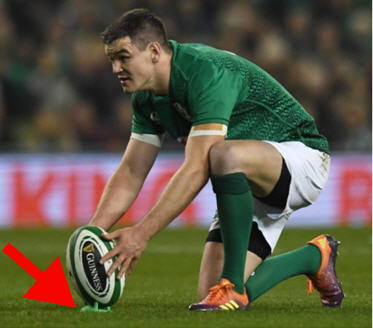The laws in Rugby Union have changed around attempts to block a conversion. But blocking is still allowed as long as you don’t use certain techniques.
There are also some circumstances in which you aren’t allowed to block a conversion. This article covers what you can and can’t do.
Can You Block A Conversion In Rugby Union?
The latest Rugby laws allow you to block a conversion by charging or jumping when kickers start their approach to take the kick.
Team-mates are no longer allowed to lift a player to block the ball.
If the block is successful, then possession is turned over to the defending team.
You may have seen defending players crouched on their try line, and charging forward at the kick. But you may never have seen it working!
But blocking is occasionally successful, which is why it’s worth trying in a tight game.
An international rugby match with a blocked conversion
Here’s an example from 1998 Bledisloe Cup match between Australia and New Zealand. Christian Cullen had just scored a cracking try for the All Blacks (watch the video from the beginning to enjoy it).
Andrew Mehrtens lined up the conversion, placed the ball, and started his run. The opposing out half, Chris Larkham, charged forward and jumped with arms stretched high.
You can hear the slap as the ball hits his hands.
Larkham wasn’t known for speed! The key here is his anticipation of the angle and height of the ball from the tee.
I’ll have another example for you in a later section that is less dramatic but very funny (the Peter Stringer example).
When Can You Charge A Conversion In Rugby?
The laws are very strict around when and from where the defending plays can start their attempt to block the conversion.
You must start from your try line
First of all, the entire defending team must be standing on or behind their try line while the kicker is preparing to take the conversion.
Sometimes you’ll see defending captains approach the referee to dispute the try. Perhaps they think there was a knock-on or some piece of foul play in the run-up to the try.
The referee may delay the conversion kick to review the play. But once the try is ruled as given, the captain and any other defender must retreat to their own try line.
If you are successful in preventing a conversion, the referee may take a look at a replay of where you started your run.
If you’re deemed to start from over the line, then the kicker will be allowed to retake the kick!
Wait for the kicker to start their approach

The kicker can adjust the ball on the tee. Usually, kickers take a few steps back and pause to set themselves. Then they’ll start their run to kick the ball. This is known as the approach.
You must time your blocking attempt to when the kicker starts the approach.
This can be contentious.
In 2019, two South African sides fought a tight Super Rugby match in Cape Town. the Stormers scored a late try in rugby overtime to draw level with the Lions.
The Stormers fly-half lined up to kick the winning conversion. He steps forward and the desperate Lions defenders rush out to charge. But the Stormers fly-half calmly bends down to re-adjust the ball.
There’s a big argument with the referee about this, but the referee ruled that the kicker hadn’t approached to take the conversion. He was allowed to set himself again and take a successful kick to win the game!
However, if you get your timing right it can win a match. Here’s another example where Joe Simmonds of the Exeter Chiefs had the opportunity to pull his team ahead at the death.
You can hear the yell of one of the players from the opposing team: “he’s moved, he’s moved”. The Saints winger races out and blocks the conversion by kicking the ball off the tee.
The kicker’s team complains, but the referee adjudicates that the winger acted within the laws. Why? This is what I hear the referee say in the video:
“He moved his shoulders, he started his run-up.”
Technically, the defending team may have infringed in another way. I’ll discuss that in a later section.
When Can’t You Block A Conversion In Rugby?
I mentioned that you can’t charge forward too early. If you do, this is an infringement.
When the defending team infringes in a way that prevents the conversion, then the kicker can take the kick again. In these circumstances, you are not allowed to attempt to block the conversion.
So, you only get one chance at this. Otherwise, it’s a free shot for the kicker.
Why Is It Legal To Charge A Conversion?

I’ll write a separate article about other types of kicks where charging is not allowed. So you can’t block kicks for goal in all circumstances.
Why is it allowed for conversions?
Well, the ethos behind this is that the defending team hasn’t infringed or done anything wrong by conceding a try. (Their coaches and supporters may think they’re the worst in the world for missing tackles, but that’s a different story).
Therefore, they shouldn’t be penalized by not being allowed to defend or disrupt the opposition’s attempt to score. As long as their disruption is not unsportsmanlike.
We’ll come to that in the next section.
What Can’t You Do When Blocking A Conversion?
The laws of Rugby Union specifically say that you can’t shout during a conversion attempt. That would be an infringement. If the kicker misses, they get a chance to take the kick again.
Basically, this is considered unsportsmanlike. I’ve seen some people mention that charging the kick is also unsportsmanlike, but as I’ve explained, it’s well within the laws.
I showed a clip earlier of an English club match where one defender can clearly be heard yelling “he’s moved”. The guy is basically urging his winger to start his run.
Technically, the shout could be considered an infringement. But the referee didn’t see (or hear) it that way.
Can you lift a teammate to block a conversion?
There was a famous block of a penalty kick years ago by the great Wallaby player and Captain, John Eales. This very tall man was hoisted by his teammates under the posts so that he could block the ball.
This wasn’t a conversion but I mention it here because eventually the Laws changed for both conversions and penalty kicks.
A player cannot be lifted by teammates in an attempt to block a conversion.
What Happens When A Conversion Is Successfully Blocked?
A successful block results in the kick not going through the posts. It doesn’t have to be a traditional charge down as we showed in the first video. In the second video in this article, the winger kicks the ball off the tee.
Here’s another block by Peter Stringer, an Irish scrum-half as clever as he was small.
Blink and you may miss what happens in this Wallabies test match against the international invitation side, the Barbarians.
James O’Connor was taking an age in his approach to the ball.
Stringer has the time to sprint forward and deftly pick up the ball. Talk about picking pockets!
You can see the wily Irishman nonchalantly jogging across the pitch with the ball under his arm. James O’Connor watches in astonishment.
Stringer can’t hare up the field to score a try, and the kicker’s teammates don’t bother trying to tackle him. When the conversion fails, the ball is considered to be out of play. Possession returns to the defending team.
In the example, the clock was in the red for half time so the players go into the dressing rooms. If this was the middle of a half, the opposition would kick out from the twenty-two.
Why Should You Try To Block A Conversion?
Most attempts to block conversions are not successful. And it’s fair to say that the attempts can look very half-hearted. So, why should you bother to try?
One reason is that it’s the only legitimate way to distract the kicker. It’s far more likely that they’ll slot the kick wide than you’ll actually be quick enough to effect a charge down.
For that reason, teams are far more likely to target young kickers who haven’t as much experience with blocking out the distraction.
And if a kicker is having a bad streak, or is known to be erratic, you’ll see even the locks haring out to pile on the pressure.
How To Block A Conversion In Rugby
It may seem to be a simple technique of racing forward as fast as you can. However, you don’t want to block the conversion with your face.
That may end up with a broken nose. I’ve known players to be sparked (knocked out) because of it.
It’s important to remember the techniques you are taught when charging down kicks in open play. Turn your head to the side, and use your arms to protect your face.
Blocking Other Types Of Kicks
The laws around blocking conversions are different to blocking kicks in open play and from penalties. We’ve got a couple of articles to help you out:
- When and how can you block penalty kicks in rugby?
- When and how can you block kicks in open play in rugby?
2 thoughts on “Can You Block A Conversion In Rugby? (Great Examples)”
Comments are closed.